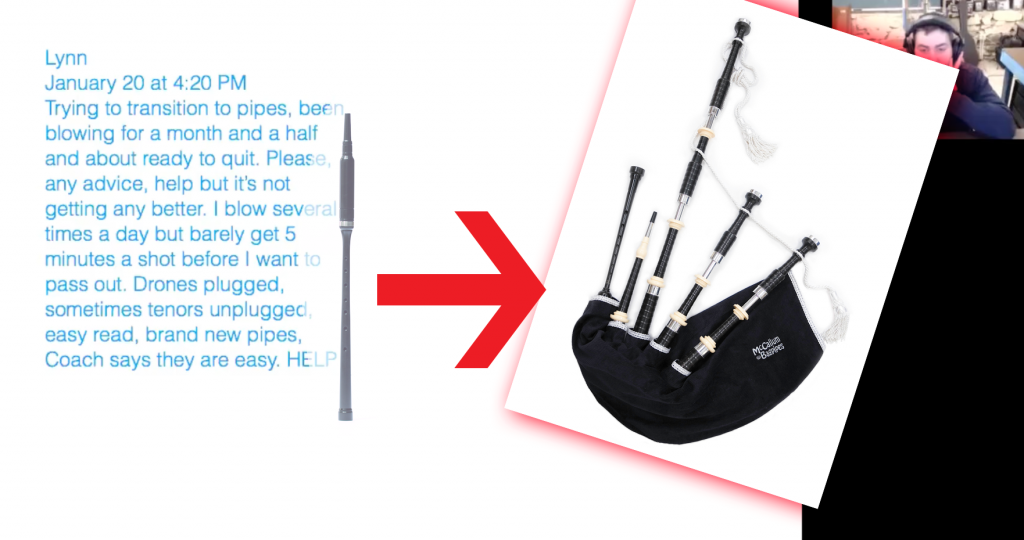Transitioning to the Pipes Without Frustration

Are you a new piper just starting bagpipes? Do you feel like you are going to pass out every time you play? Should transitioning to the bagpipes be so hard?
Andrew and Carl assuage your fears with a simple process to make your transition a success. Spend less time frustrated and more time playing pipes.
Video Transcription:
Andrew:
Lynn says, "Trying to transition to the bagpipes. I've been blowing for a month and a half and I'm about ready to quit. Please, any advice? Help! It's not getting any better. I blow several times a day, but barely get five minutes a shot before I want to pass out. Drone's plugged, sometimes tenor's unplugged, easy reed, brand new pipes, coach says they're easy. Help!"
Right, this is kind of sad. Think about all the work someone has to put in on the practice chanter to get to the point where they're transitioning to the pipes and then this happens. There is a better way and we're about to release it at Dojo U, the new and updated transitioning to the pipes process. We'll be releasing it in the form of a course.
Okay, let's zero in on the issue here. Easy reed, how will she know if the reed is actually the correct strength for her? Start by making sure you can blow 16 beats on that reed. Then, even before you put the reed in the pipes, I would recommend starting with no drones and doing the four questions of bagpipe maintenance, making sure the bagpipe is set up the right way and that we, the student, understands how to maintain it, okay? Then, I would play the pipes with no reeds going. You heard that right, zero reeds going.
I would put the pipes up under my shoulder and make sure I had great posture next. I wonder if Lynn has done that or not? Then, I would open up one drone. I wouldn't start with the chanter. I would open up one drone and start to learn about the different aspects of how a drone works. Anybody can play one drone.
Okay? You won't be feeling like you're about to quit when that happens. Then, two drones. Then, I would practice some strike ins and some cutoffs, no chanter. Let the chanter be the last step. Then, as long as we've got a chanter reed that's the correct strength, you will be able to do it and it will be easy.
Now, I just saw this question from Barb, "I still have days like that and I'm still uneven. Many times you still play with no drones." Barb, I recommend, especially once we release this transitioning into the pipes course, I recommend that you go back to square one and relearn. Somewhere in that process, you will find what causes you to still have days like that.
Carl:
It's unlikely that the four questions are all answered 'yes' or that the first four maintenance questions. Even on a brand new set of pipes, there's air leaking somewhere. I guarantee it in Lynn's case. I guarantee it, there's got to be some air leaking there. Then as Andrew said check the reeds. We got to go from the beginning, though. Lynn or Barb, you guys have to be responsible for that instrument and know how to fix it and test it, because that's the only way. It changes way too quickly. You can have a leak tomorrow that is easy to fix, but if you're not looking for it and you aren't responsible for it, it's going to plague you. Then there's some issues maybe with the bag slipping out, but that gets back down to posture. That's why it's better to go through our new transitioning course, which is coming.
Check out the new Transitioning to the Bagpipes Course:
https://pipersdojo.lpages.co/transitioning-to-the-bagpipes-v2-course-flash/





Responses